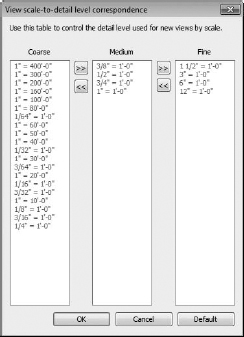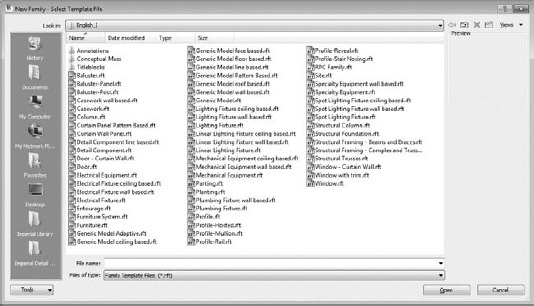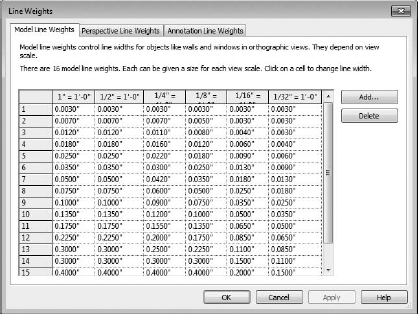Understanding the Family Editor
Plenty of generic 3D modeling applications allow you to create content that will be used in designing your buildings, and modeling in 3D is certainly a big part of the Family Editor. But the key to the Family Editor isn't that you're modeling anything but that you're modeling something. Something specific. The thing that you're trying to design is meant to be a particular thing and behave in a particular way.
So when you're modeling in the Family Editor, you're not just trying to model how and what something: you're also trying to predict how it might change. Anticipating change is key to creating great, flexible content that is able to quickly and easily reflect your design changes.
For example, take a simple table. If you were to model this table in a program like SketchUp, what you'd have when you're done is exactly what you've modeled. But think about the design process and how something might need to change: height, length, width, and material. In the real world, each of these parameters is critical. Suppose you have only three options for each of these values—this results in 81 permutations! Who has time to manually create each of these options? But this is what you'd have to do if you were using a generic modeler rather than Revit, where these options are driven by rules. In Revit, creating additional options can be done on the fly.
As you probably know, your design is going to change. Being able to anticipate change will help you not only understand how best to approach Revit but also how to keep from becoming a frustrated designer, faced with what seems to be unpredictable whims and demands of your clients, consultants, and contractors.
Putting the Family Editor in Context
We'll start by putting the Family Editor in context. Without oversimplifying or complicating matters, think about how you'd organize a design problem: constraints, building, content, documentation, and workflow. Interestingly enough, this approach parallels how Revit also views the design process: data, host families, component families, views, and worksharing.
Data Before you start designing in 3D, you're going to need some context! What are the likely levels in elevation or key structural locations in the plan? Data helps give context to almost all the building and project components. Without data (at least levels), it's impracticable to start designing your project. Fortunately, the default Revit template has two levels, and the default view is level 1.
Keep in mind that everything you create in the Family Editor needs to understand its relationship in the project. Even if it's not relating to geometry, it's relating to the data in the project: a grid or level. Knowing how your family component will respond to data in the project environment is critical.
Host Families In Revit, the main building elements are called host or system families. Host and system families are all geometry, but it's geometry that's built within the project environment, not in the Family Editor (although some host families may contain component families). Walls, Floors, Roofs, and Ceilings are the most common host families.
After data, families often have to be hosted by system families (or at least need to maintain a particular relationship). You need to know whether your family will have to maintain some relationship to system families in your project.
Component Families Component families are created outside the project environment. They're loaded into the project and then distributed as needed. When you change the type properties of a component family, you're changing the properties of all components of the same type. But when you change the instance properties of a family component, you're changing only the instances that you've selected.
Views The views of your model include schedules, 2D views (plans, elevations, and sections), 3D views (orthographic and perspective), or even drafting views for drawing whatever you like and then associating it with the model.
Many views have scale- and detail-level properties. The detail level is particularly important to consider when creating a family component, because you often don't need to show every facet and detail in every view and scale. Fortunately, this view scale-to-detail level relationship is automatically defined in Revit. So once you place your family component in Revit, it will automatically hide or reveal detail based on the scale of a view in your project (Figure 15.1).
FIGURE 15.1 Default view scale detail

Worksharing Worksharing allows all your team members to access the Revit project at the same time in a flexible, nonlinear manner. One moment you're moving a wall, the next moment you're adding a door, and the next you're adding a tag or changing the look of the schedule. Revit is able to handle this kind of nonlinear and unpredictable change quickly and easily.
Choosing the Right Family Template and Category
![]() Now that you have a better understanding of where your component families sit in relation to your overall project, we'll discuss some specifics. If you attempt to create a new family (Application menu
Now that you have a better understanding of where your component families sit in relation to your overall project, we'll discuss some specifics. If you attempt to create a new family (Application menu ![]() New
New ![]() Family), you'll notice that there are a lot of different templates. Choosing the right template is important (Figure 15.2).
Family), you'll notice that there are a lot of different templates. Choosing the right template is important (Figure 15.2).
FIGURE 15.2 Template categories

Selecting the right template determines a lot of behavior about the family. In some cases, you can change the category of the template that you've selected from one to another. For example, in Figure 15.3, a Generic Models family template is capable of being turned into another template. This is helpful if you need a family to schedule in a different category than one you might have initially selected. But in many cases, categories cannot be switched, and nonhosted or non-face-based components cannot be changed to hosted or face-based (and vice versa). That's why you need to choose the category carefully.
FIGURE 15.3 Switching between family categories

Some categories are hardwired for specific behavior, and if you change from that category to another, you can't go back. For example, if you start a family in one of the baluster templates, you can switch to another template. But after having done so, you cannot switch back to a baluster family. Knowing what you want to create before you begin helps you eliminate the amount of switching you need to do later in the process.
SCHEDULING
Remember as you start a new component that the category you select ultimately controls how the family component will schedule. If you're trying to determine which template to select, it will be helpful to ask yourself or your team members how the family should schedule. Figure 15.4 shows all the schedule categories that are available in Revit.
FIGURE 15.4 New Schedule dialog box

PROJECTION AND CUT VALUES
Another important characteristic of the family category is that it will control whether a family will “cut” when intersecting a view plane (plan, section, elevation, and so on). For example, convention dictates that when furniture encounters a cut plane, you should show a projected view.
Revit respects this convention by cutting some categories while not cutting others. You can figure out which categories cut or don't cut by going to the Manage tab and clicking Object Styles (Figure 15.5).
FIGURE 15.5 Cut properties via Object Styles
As you can see in Figure 15.5, categories such as Casework, Ceilings, and Columns cut, whereas categories such as Electrical Equipment, Electrical Fixtures, and Furniture do not.
Another important characteristic of the object properties is the default line weights given to objects when they're placed in a project. These line weights affect both projection and cut values. Just remember that it's probably best not to manipulate the Line Weights dialog box (Figure 15.6) unless you know what you're doing. If you intend to increase or decrease the line weight of a category of objects, use the object properties rather than the Line Weights dialog box.
FIGURE 15.6 Line Weights dialog box

ASSIGNING PARAMETERS
As you start to get into the parameter that can control a family's geometry, material, or other value, keep in mind that it's not always necessary to create components as fully parametric. This is especially true of the first pass. The location and spacing of content is often more important than whether the family can flex geometrically.
Nonparametric families often occur when the component being modeled is specific and highly unique. It may have parameters that control materials or a few other values, but not much more. At this point, little more than selecting the right category and insertion point is necessary. It's often far more efficient to maintain design relationships by modifying the component in the Family Editor and then reloading it into the project—at least until more is known about the design. When more is known, you can open the family and embed more parameters.

